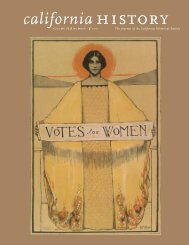Volume 90, Number 1 - California Historical Society
Volume 90, Number 1 - California Historical Society
Volume 90, Number 1 - California Historical Society
You also want an ePaper? Increase the reach of your titles
YUMPU automatically turns print PDFs into web optimized ePapers that Google loves.
64<br />
notes<br />
17 Marín, “La práctica del ribat en al-Anda-<br />
lus,” esp. 196–97.<br />
18 Lourie, “The Confraternity,” 167–68.<br />
19<br />
Dodds, Menocal, and Balbale, The Arts<br />
of Intimacy, 130. For more examples of<br />
Almoravid fervor, see Alejandro García-<br />
Sanjuán, “Jews and Christians in Almoravid<br />
Seville as Portrayed by the Islamic Jurist<br />
Ibn ‘Abdun,” Medieval Encounters 14 (2008):<br />
78–98, esp. 82. On another note, the word<br />
Almoravid may come from the Arabic al-<br />
Murabitun, meaning “those bound together”<br />
or “those who perform ribat.”<br />
20<br />
Fernández-Morera, “The Myth of the<br />
Andalusian Paradise,” 24. One scholar suggests<br />
that the Almohades practiced some<br />
form of ribat; see Gerald Elmore, “New<br />
Evidence on the Early Life of Ibn al-‘Arabi,”<br />
Journal of the American Oriental <strong>Society</strong> 117,<br />
no. 2 (Apr.–June 1997): 347–49.<br />
21<br />
José Enrique López de Coca Castañer,<br />
“Institutions on the Castilian-Granadan<br />
Frontier,” in Medieval Frontier Societies, eds.<br />
Robert Bartlett and Angus Mackay (Oxford:<br />
Clarendon Press, 1989), 127, and “Ibn Hudhayl<br />
al-Andalusi, 1354–1362,” Schola Forum,<br />
Martial Arts, History and Warfare for Adults,<br />
http://www.fioredeiliberi.org/phpBB3/<br />
viewtopic.php?f=17&t=18439.<br />
22<br />
Richard Martin, “The Religious Foundations<br />
of War, Peace, and Statecraft in Islam,”<br />
in Just War and Jihad, <strong>Historical</strong> and Theoretical<br />
Perspectives on War and Peace in Western<br />
and Islamic Traditions, eds. John Kelsay and<br />
James Turner Johnson (New York: Greenwood<br />
Press, 1991), 96–97.<br />
23<br />
By no means do we wish to promote the<br />
idea that Islam is a faith dedicated to war.<br />
Other commentators, though, have no trouble<br />
making the claim. See Pamela Geller,<br />
Stop the Islamization of America: A Practical<br />
Guide to the Resistance (Washington, DC:<br />
WNDBooks, 2011), and Robert Spencer, The<br />
Politically Incorrect Guide to Islam (and the<br />
Crusades) (Washington, DC: Regnery Press,<br />
2005). Mr. Spencer also maintains the website<br />
Jihad Watch. In any event, one does not<br />
have to read far to find verses like 4:95, in<br />
which God says that He will honor “those<br />
who fight, above those who stay at home,”<br />
or 9:5, also known as “the sword verse,”<br />
where the faithful learn that “when the<br />
sacred months are over, slay the idolaters<br />
wherever you find them.” Also see Helen<br />
Adolf, “Christendom and Islam in the Mid-<br />
<strong>California</strong> History • volume <strong>90</strong> number 1 2012<br />
dle Ages: New Light on ‘Grail Stone’ and<br />
‘Hidden Host,’” Speculum 32, no. 1 (January<br />
1957): 103–15, esp. 107–8.<br />
24<br />
All ideas about using war to “command<br />
the good and forbid evil” come from Martin,<br />
“The Religious Foundations of War, Peace,<br />
and Statecraft in Islam,” 96–97, 106–7.<br />
One version of the phrase can be found in<br />
Qur’an, 3:104.<br />
25<br />
Martin, “The Religious Foundations of<br />
War, Peace, and Statecraft in Islam,” esp.<br />
102–11.<br />
26<br />
Malik produced the Muwatta sometime<br />
in the eighth century. See Maribel Fierro,<br />
“Mawali and Muwalladun in al-Andalus” in<br />
Patronate and Patronage in Early and Classical<br />
Islam, eds. Monique Bernards and John<br />
Nawas (Leiden, Netherlands: Brill, Academic<br />
Publishers, 2005), 202–4 and Fernández-<br />
Morera, “The Myth of the Andalusian<br />
Paradise,” 28. On another note, some commentators<br />
say Sunnis have more than four<br />
schools of thought. We let others decide the<br />
debate. For more views of Malik, see Mu’li<br />
Yusuf ‘Izz al-Din, Islamic Law from <strong>Historical</strong><br />
Foundations to Contemporary Practice<br />
(Edinburgh, Scotland: Edinburgh University<br />
Press, 2004); Fierro, “Mawali and Muwalladun<br />
in al-Andalus,” esp. 202–4.<br />
27<br />
Admittedly, warriors did not receive<br />
license to indulge in unrestrained carnage.<br />
Their violence occurred within a holy, limited<br />
moment where they alone risked death<br />
and destruction. The weak, or any other<br />
person or thing incapable of giving offense,<br />
should suffer no harm. In the Muwatta,<br />
verse 21:3.11 says that men at war must<br />
not “kill women and children, or an aged,<br />
infirm person.” Furthermore, the warriors<br />
learn that they cannot “cut down fruitbearing<br />
trees” and “destroy an inhabited<br />
place.” Even the distribution of treasure and<br />
livestock seized from the enemy followed a<br />
certain protocol. Verse 21:6 counseled that<br />
only “free men who have been present at<br />
battle” could receive a share of booty. Still,<br />
the Muwatta praised the warrior’s efforts.<br />
In Verse 21.1, the Muwatta proclaims that<br />
“someone who does jihad” follows the way<br />
of God. Muhammad adds: “Allah laughs at<br />
two men. One of them kills the other, but<br />
each of them will enter the garden; one<br />
fights in the way of Allah and is killed, then<br />
Allah turns [in forgiveness] to the killer<br />
so he fights [in the way of Allah] and also<br />
becomes a martyr.” Verse 21.14.27 features<br />
Muhammad saying, “I would like to fight in<br />
the way of Allah and be killed, then brought<br />
to life again so I could be killed, and then<br />
brought to life again so I could be killed<br />
again.”<br />
28<br />
Some siyars seemed spurious, a question<br />
that need not concern us at this time. For a<br />
more thorough discussion, see Muhammad<br />
Munir, “Islamic International Law (Siyar):<br />
An Introduction,” Research Papers, Human<br />
Rights Prevention Centre (HRCPC) 7, no. 1–2<br />
(2007): 923–40, http://papers.ssrn.com/<br />
sol3/papers.cfm; Bonner, Jihad in Islamic<br />
History, 111; Jean-Pierre Filiu, Apocalypse in<br />
Islam, tr. M. B. DeBevoise (Berkeley: University<br />
of <strong>California</strong> Press, 2011), 32, 36–37.<br />
29<br />
Michael Bonner, “Some observations<br />
concerning the early development of Jihad<br />
on the Arab-Byzantine Frontier,” Studia Islamica<br />
no. 75 (1992): 5–31, esp. 7.<br />
30<br />
Ibid., 23–26.<br />
31<br />
Marín, “La práctica del ribat en al-Andalus,”<br />
197.<br />
32<br />
For more comment on this subject of<br />
holy men going to fight, see,Bonner, “Some<br />
observations,” 7; Maribel Fierro, “Spiritual<br />
Alienation and Political Activism: The<br />
guraba in al-andalus during the Sixth/<br />
Twelfth Century,” Arabica 47, no. 2 (2000):<br />
230–60, esp. 233–34, 236.<br />
33<br />
Fierro, “Spiritual Alienation,” 247.<br />
34 Bonner, Jihad in Islamic History, 112.<br />
35 Fierro, “Spiritual Alienation,” 257.<br />
36<br />
Castro, The Structure of Spanish History,<br />
204. The Diccionario de la Lengua Española,<br />
2 vols. (Madrid: Real Academia Española,<br />
1992) provides the etymology for each of<br />
the above words and illustrates their Arabic<br />
origins.<br />
37<br />
Thomas Glick, Islamic and Christian Spain<br />
in the Early Middle Ages (Princeton: Princeton<br />
University Press, 1979), 50–55.<br />
38<br />
Mariam Rosser-Owen, Islamic Arts<br />
from Spain (London: V&A Publishing,<br />
2010), 21; Maria Rosa Menocal, The Ornament<br />
of the World: How Muslims, Jews, and<br />
Christians Created a Culture of Tolerance in<br />
Medieval Spain (New York: Little, Brown,<br />
and Company, 2002); Álvaro of Córdoba<br />
quoted in William Dalrymple, “Inside the<br />
Madrasas,” The New York Review of Books, 52<br />
(Dec. 1, 2005), http://www.nybooks.com/<br />
articles/18514; Alejandro García-Sanjuán,<br />
“Jews and Christians in Almoravid Seville as<br />
Portrayed by the Islamic Jurist Ibn ‘Abdun,”<br />
Medieval Encounters 14 (2008): 78–98, esp.









